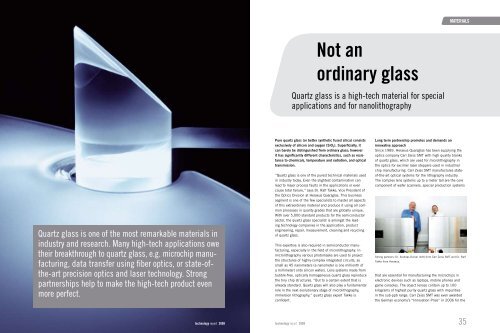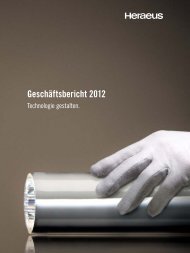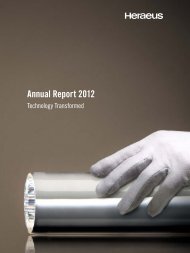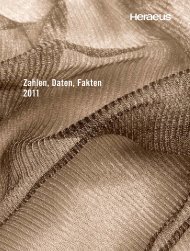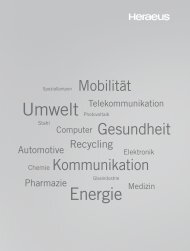Microlithography - About Heraeus
Microlithography - About Heraeus
Microlithography - About Heraeus
You also want an ePaper? Increase the reach of your titles
YUMPU automatically turns print PDFs into web optimized ePapers that Google loves.
Quartz glass is one of the most remarkable materials in<br />
industry and research. Many high-tech applications owe<br />
their breakthrough to quartz glass, e.g. microchip manufacturing,<br />
data transfer using fiber optics, or state-ofthe-art<br />
precision optics and laser technology. Strong<br />
partnerships help to make the high-tech product even<br />
more perfect.<br />
technology report 2008 technology report 2008<br />
Not an<br />
ordinary glass<br />
Quartz glass is a high-tech material for special<br />
applications and for nanolithography<br />
Pure quartz glass (or better synthetic fused silica) consists<br />
exclusively of silicon and oxygen (SiO 2). Superficially, it<br />
can barely be distinguished from ordinary glass; however<br />
it has significantly different characteristics, such as resistance<br />
to chemicals, temperature and radiation, and optical<br />
transmission.<br />
“Quartz glass is one of the purest technical materials used<br />
in industry today. Even the slightest contamination can<br />
lead to major process faults in the applications or even<br />
cause total failure,” says Dr. Ralf Takke, Vice President of<br />
the Optics Division at <strong>Heraeus</strong> Quarzglas. This business<br />
segment is one of the few specialists to master all aspects<br />
of this extraordinary material and produce it using all common<br />
processes in quality grades that are globally unique.<br />
With over 5,000 standard products for the semiconductor<br />
sector, the quartz glass specialist is amongst the leading<br />
technology companies in the application, product<br />
engineering, repair, measurement, cleaning and recycling<br />
of quartz glass.<br />
This expertise is also required in semiconductor manufacturing,<br />
especially in the field of microlithography. In<br />
microlithography various photomasks are used to project<br />
the structures of highly-complex integrated circuits, as<br />
small as 45 nanometers (a nanometer is one millionth of<br />
a millimeter) onto silicon wafers. Lens systems made from<br />
bubble-free, optically homogeneous quartz glass reproduce<br />
the tiny chip structures. “But to a certain extent that is<br />
already standard. Quartz glass will also play a fundamental<br />
role in the next evolutionary stage of microlithography,<br />
immersion lithography,” quartz glass expert Takke is<br />
confident.<br />
mATErIALS<br />
Long term partnership promotes and demands an<br />
innovative approach<br />
Since 1989, <strong>Heraeus</strong> Quarzglas has been supplying the<br />
optics company Carl Zeiss SMT with high quality blanks<br />
of quartz glass, which are used for microlithography in<br />
the optics for excimer laser steppers used in industrial<br />
chip manufacturing. Carl Zeiss SMT manufactures stateof-the-art<br />
optical systems for the lithography industry.<br />
The complex lens systems up to a meter tall are the core<br />
component of wafer scanners, special production systems<br />
Strong partners: Dr. Andreas Dorsel (left) from Carl Zeiss SMT and Dr. Ralf<br />
Takke from <strong>Heraeus</strong>.<br />
that are essential for manufacturing the microchips in<br />
electronic devices such as laptops, mobile phones and<br />
game consoles. The object lenses contain up to 100<br />
kilograms of highest purity quartz glass with impurities<br />
in the sub-ppb range. Carl Zeiss SMT was even awarded<br />
the German economy’s “Innovation Prize” in 2006 for the<br />
35
Would you have known?<br />
Will quartz glass<br />
confirm Einstein’s theory?<br />
Not an ordinary glass<br />
In 2005, the ambitious NASA<br />
project “Gravity Probe B” began<br />
its decisive experimental phase<br />
when the research satellite of<br />
the same name was successfully<br />
launched to a height of 640<br />
kilometers. The aim, to confirm<br />
or refute important predictions<br />
of Einstein’s General Theory of<br />
Relativity. Over 18 months, the<br />
satellite collected vital measurement<br />
data; the final evaluation<br />
of the experiment is still pending<br />
however. The “Gravity Probe B”<br />
satellite contained cutting-edge<br />
technology from <strong>Heraeus</strong>. The<br />
core component consisted of<br />
a 53 centimeter long block of<br />
quartz glass, attached to a quartz<br />
glass telescope and containing<br />
four gyroscopes. These ping pong<br />
ball-sized spheres, rotating at<br />
around 5,000 rpm, constitute<br />
the roundest objects in the world.<br />
They are made of the high-purity<br />
quartz glass Homosil, coated with<br />
superconducting niobium. Such<br />
exceptional projects contribute<br />
added value for the company –<br />
to continuously perfecting the<br />
company’s know-how as an<br />
expert for precisely manufactured<br />
high-performance quartz glass.<br />
development of the first immersion<br />
optics for industrial chip production,<br />
type “Starlith 1700i”. The quartz<br />
glass Suprasil ® 401 is used for the<br />
award-winning optics.<br />
In accordance with Moore’s Law –<br />
easily one of the best known laws<br />
in the world of technology and valid<br />
since 1965 – the storage density<br />
and power of microchips doubles<br />
every two years. Correspondingly,<br />
new generations of objective lenses<br />
are required to transmit ever finer<br />
structures. The development of synthetic<br />
quartz glass has to keep up.<br />
With Suprasil ® 501, the quartz glass<br />
specialist has already developed the<br />
next generation, which is now used<br />
in the latest optics at Carl Zeiss. It<br />
takes two to three years to develop a<br />
new, even more homogeneous variety<br />
of quartz glass to a market-ready<br />
stage.<br />
Dr. Andreas Dorsel, General Manager<br />
for Lithography Optics at Carl<br />
Zeiss SMT, is certain that development<br />
and cooperation in the field of<br />
microlithography still hold a lot of<br />
potential. “New lithography systems<br />
will continue to be significantly<br />
influenced in their success by new<br />
materials. The capacity of the optical<br />
materials to withstand the laser<br />
radiation used in the lithography<br />
process is an especially important<br />
factor. With increasingly homogeneous<br />
varieties of quartz glass, even<br />
finer structures can be produced on<br />
the microchips in the coming years,<br />
probably even below 30 nanometers.”<br />
Withstand 200 billion laser pulses<br />
unharmed<br />
<strong>Heraeus</strong> responded to this challenge!<br />
“The exceptional optical characteristics<br />
of our lens material, such as<br />
radiation resistance, have to remain<br />
practically unchanged for the entire<br />
service life required of a lens objective,<br />
generally more than 10 years,”<br />
Dr. Bruno Uebbing, Business Unit Manager of <strong>Microlithography</strong><br />
at <strong>Heraeus</strong> Quarzglas for Carl Zeiss SMT, specifies<br />
a decisive requirement for the high-tech material. In its<br />
lifetime as lens material in stepper optics, for example,<br />
quartz glass has to withstand bombardment with over 200<br />
billion laser pulses undamaged, and must display no more<br />
than the tiniest refractive index deviations or transmission<br />
losses.<br />
Quartz glass is a very sensitive optical material for this application,<br />
and must fulfill the highest standards in terms<br />
of transmission, stress induced birefringence, homogeneity<br />
of the index of refraction, and resistance to highenergy<br />
laser radiation. The production of such high-purity<br />
material is a tremendous challenge. At the same time, it is<br />
also vital that the product quality be ensured and verified<br />
throughout the production process by means of analytical<br />
procedures. “In addition to new, customer-defined quartz<br />
Quartz Glass in <strong>Microlithography</strong><br />
In microlithography, various photomasks are used to<br />
project the small, highly-complex integrated circuits<br />
only nanometers in size onto silicon wafers. Lens<br />
systems made of bubble-free, optically highly homogeneous<br />
quartz glass reproduce the tiny chip structures,<br />
and further reduce them by up to 4 times with sharp<br />
definition. Quartz glass also plays a fundamental role in<br />
the current evolutionary stage of microlithography, immersion<br />
lithography. Immersion lithography is a special<br />
process in microlithography. <strong>Heraeus</strong> has developed new<br />
types of synthetic quartz glass for this technology that<br />
are characterized by improved laser resistance, higher<br />
homogeneity and optimized stress induced birefringence,<br />
and are particularly suited for lithography applications<br />
in the range of 193 nanometers. The special feature of<br />
immersion technology is that a film of high-purity water<br />
is introduced between the optics and the wafer. This<br />
facilitates a higher optical resolution. As a consequence,<br />
even smaller structural widths (smaller than 45 nanometers)<br />
can be produced than previously. It is therefore not<br />
without reason that the specialists are now talking about<br />
nanolithography.<br />
Below left: Quartz glass lenses made from Suprasil ® are used<br />
in the immersion optics of Carl Zeiss SMT.<br />
technology report 2008 technology report 2008<br />
glass qualities, we therefore also develop chemical and<br />
physical methods for qualifying the characteristics, for<br />
example for measuring the stress induced birefringence,”<br />
says physicist Ralf Takke.<br />
Another reason for the innovative developments in the<br />
field of microlithography is the effective customer-supplier<br />
relationship, which has built up to a high level of trust between<br />
<strong>Heraeus</strong> Quarzglas and Carl Zeiss SMT AG. Amongst<br />
other aspects, the strong customer orientation is demonstrated<br />
by the fact that <strong>Heraeus</strong> discusses joint planning<br />
and development programs with Carl Zeiss’ high-tech<br />
forge at Oberkochen every two weeks. “Carl Zeiss expects<br />
its suppliers to meet very high standards when it comes<br />
to quality of products and services. For us, being distinguished<br />
with the Supplier Award 2006 as one of the best<br />
suppliers was both confirmation and motivation at once,”<br />
says Bruno Uebbing.<br />
Image source: Carl Zeiss<br />
mATErIALS<br />
The close cooperation was reinforced yet further in 2007.<br />
<strong>Heraeus</strong> is now an “Official Carl Zeiss SMT Supply Chain<br />
Partner”. The partnership agreement represents an important<br />
milestone in the longstanding relationship between<br />
these two technology companies. The best of conditions<br />
under which to spend the coming years continuing to<br />
prove Moore’s Law together with Carl Zeiss. JW<br />
Want to know more?<br />
Dr. Bruno Uebbing<br />
Division Optics<br />
<strong>Heraeus</strong> Quarzglas GmbH & Co. KG, Quarzstr. 8, 63450 Hanau<br />
Phone: +49 (0) 6181.35-6408,<br />
E-mail: bruno.uebbing@heraeus.com<br />
Internet: www.heraeus-quarzglas.com<br />
Carl Zeiss SMT: www.smt.zeiss.com<br />
37


